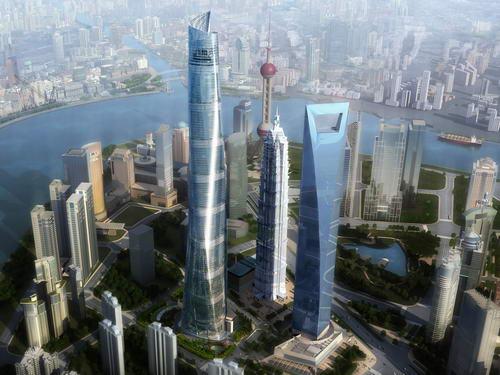Nation provides a business lifeline to struggling architect firms in the United States and Europe
BEIJING: China's construction boom is providing a lifeline for the world's leading architecture firms, which have been hit hard by the economic crisis.

A model of the 632-meter-high Shanghai Tower. It is scheduled to be completed in 2014 and will be higher than the nearby Jin Mao Tower and Shanghai World Financial Center in the Pudong district of Shanghai. [PROVIDED TO CHINA DAILY]
In the United States, architectural firms have shed a third of their jobs with fee income similarly down since the summer of 2008, according to the American Institute of Architects.
Their salvation has been China, which has developed an almost insatiable appetite for the latest building technology and design.
This has been symbolized in the past few weeks with the super columns emerging from the foundations in the Pudong district of Shanghai of what will be China's tallest building.
The 632-meter Shanghai Tower is set to be completed in 2014 and will dwarf the nearby Jin Mao Tower and Shanghai World Financial Center - only the Burj Dubai in the Arabian Gulf will stand taller on the world stage.
Dan Winey, managing director of Asia for international architecture firm Gensler, which designed the building, said China was an adventure for many firms.
The practice has offices in Shanghai and Beijing and is hoping to open others in Chengdu and Shenzhen.
"The really exciting thing about China is that clients are willing to take the risk and try something different. China has become a living laboratory for all of us. We are doing a lot of things a lot of developers wouldn't try in the United States," he said.
The contrast with the United States - and to some extent Europe also - could not be starker.
Kermit Baker, chief economist of the American Institute of Architects, said firms have been hit hard.
"Demand just fell off a cliff when the economic crisis began. The recession is only second in magnitude to the Great Depression (of the 1930s) and construction activity completely dried up. The loss of 8 million payroll positions means there is less demand for office space," he said.
Mark Latham, head of office services for international real estate consultants C.B. Richard and Ellis, based in Shanghai, said China's banks and State-owned enterprises are behind the demand for new buildings.
"They want to build the iconic buildings and badge them with their own identities so they get their own corporate identity on the skyline," he said.
"The premium end office space used to be dominated by the multinational occupiers but the Chinese companies are now much more active."
It is not that China's major cities have completely escaped the economic crisis. Office rents fell by 23.8 percent in Shanghai from the second quarter of 2008 to the fourth quarter of last year and the vacancy rate increased by 8.6 percent. Billions of yuan continue to get diverted into both new commercial and residential development.
Paul Katz, president of Kohn Pederson Fox (KPF), the New York-based international firm of architects, said it was not as if everyone could relax and just throw up a building in China anyhow.
"You can't just slap it up," he said. "In the inner cities the planning process is quite considered. The review panels will consider everything very carefully."
KPF, which has had a presence in the country since the early 1990s, now gets some 30 percent of its work from China. Its international diversity has helped it during the recent downturn.
"In the United States commercial work has become pretty much non-existent but it wasn't a significant amount of work. We work on a lot of university projects but even a lot of endowments have been reduced," added Katz.
Despite new landmark buildings dotted along the skyline, much of China's architecture over recent years does not have a great international reputation.
Many of the country's cities still have many poorly designed concrete residential and commercial buildings, much of it decaying, even though it may have been built in the last two decades.
"General contractors 10 years ago only knew how to build one building and that was basically a concrete one. They didn't know how to do much of anything else, " said Winey at Gensler.
"If you look at the quality 10 years ago, it was absolutely terrible. There have been major strides made even in the last five years. It isn't quite to international standards but it is getting much better. It has been dealing with international firms that have improved things from both a technical and engineering perspective."
There is a sense among architects that Chinese developers have gained a lot of experience and have a clearer idea of how they want buildings to perform.

Paul Katz, president of Kohn Pederson Fox, said that in the inner cities the planning process was quite considered. The review panels will consider everything very carefully. [PROVIDED TO CHINA DAILY]
New market trend"Chinese developers in some cities are now on their second and third waves of development and have much higher aspirations of what they would like from their buildings in terms of their sustainability, quality and utility and also efficient use of materials, " added Katz at KPF.
"The inhabitants of cities also have greater lifestyle expectations and want something much more sophisticated than 15 years ago. It is hard to believe how quickly this has happened."
Latham at C.B. Richard and Ellis said the demand for quality buildings went right down to workers themselves.
"The competition for talent at the moment is tight and Chinese firms need to provide a working environment that is comparable with their international counterparts in order to attract talent," he said.
The speed at which buildings in China can be built still astounds Western architects used to having to battle it out with planners, often having to go through public planning inquiry hearings.
"If you look at the timeframe of a typical project in San Francisco it would take from the beginning of inception to completion around 10 years. The same project would take you three years or less in China," added Winey at Gensler.
Katz said one of the biggest changes in recent years has been the quality of construction materials available in China.
"When we first came to China everything was imported, from the glass and metal to the elevators. Now everything is manufactured domestically and the quality of the materials is of the highest level," he said.
The level of building design in China is now such that international architectural firms believe that many of the new innovations being tried out here will find their way into buildings in the West. The East could be at the vanguard of change.
"A lot of what we do in China, certainly from the technology perspective, will be brought back to the United States and Europe," added Winey.





